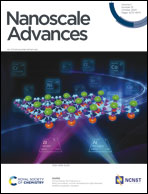Understanding the thermal conductivity variations in nanoporous anodic aluminum oxide†
Abstract
Anodic porous alumina (AAO) templates, also known as nanoporous anodic alumina (NAA) platforms or membranes, are widely used as templates in nanoscience and nanotechnology. During fabrication, characterization, or device performance, they are sometimes exposed to heat treatments. We have found that the thermal conductivity of AAO is strongly dependent on the temperature at which the sample is exposed, showing a certain variation even at very low temperatures, such as 50 °C. Because of this, we have performed a study of the thermal conductivity (k) variation for different AAO templates using 3ω-Scanning Thermal Microscopy (3ω-SThM) as a function of the annealing temperature. The AAOs studied in this work were produced in the most common electrolytes – sulfuric, oxalic, and phosphoric acids, and heated from RT up to 1100 °C. To explain these variations in an in-depth and enlightening manner, structural characterization of the different nanoporous aluminas has been performed. It is shown that even at low temperatures, below 100 °C, the AAOs lose water, which explains the reduction of their thermal conductivity. The minimum value of thermal conductivity can be found for AAO samples prepared in sulfuric acid and heated at 100 °C (0.78 ± 0.19 W m−1 K−1), which corresponds to a 50% reduction from the original value. It has also been found that for AAO annealed above 950 °C, the variations in the thermal conductivity are mainly related to phase transitions from amorphous to crystalline alumina and gas evolution of CO2, or SO2 and SO, depending on the electrolyte used during the anodization. This is also an indication that the counter ions are trapped inside the alumina template during the anodization process. And, their presence determines the crystallization temperatures at which the different crystalline phases are formed. And so, the variations in thermal conductivity are measured. The thermal conductivity values of the AAO can reach values as high as 4.82 ± 0.36 W m−1 K−1 for AAO samples prepared in oxalic acid and heated up to 1300 °C. We consider that the understanding of the changes in their thermal conductivity can explain the different values in the thermal conductivity of the AAO template found in the literature and draw some attention to the importance of the history of the AAO platforms that are to be used or measured, since it may change the final thermal properties of the template or device.



 Please wait while we load your content...
Please wait while we load your content...